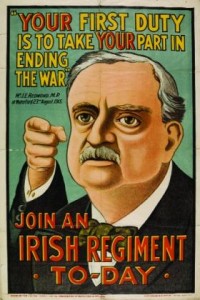Redmond, O’Leary and O’Brien
Published in 20th-century / Contemporary History, Issue 3 (May/Jun 2007), Letters, Volume 15
John Redmond recruiting poster—part of the ‘Gallant Sons: Irishmen and the Great War’ exhibition at the National Library, Kildare Street, in April 2007. (National Library of Ireland)
Sir,
—It is remarkable that in the last issue (HI 15.2, March/April 2007), a non-theme number, there is a ‘platform’ article on John Redmond, a ‘short’ on John O’Leary and a longer ‘sources’ article centred around William O’Brien, three of the leading figures of the different strands of Irish nationalism at the beginning of the last century. Unfortunately the first two tend to reinforce Irish historical myths developed over the last four decades.
In Redmond’s case, it is not that, as Walter Forde writes, ‘the historical judgement today would be much kinder than that of, say, 40 years ago’. In this writer’s memory, the third-level history departments of the earlier time were dominated by his apologists. It is doubtful, too, whether he did create ‘in Britain a greater awareness of Ireland’s needs’; it is not clear that there had been an actual swing in British popular opinion between the second and third Home Rule bills. Above all, it is not true that ‘Redmond was incredibly unlucky’. Rather it is that his good luck ran out some time between the introduction of the third Home Rule bill and the Easter Rising. Despite his undoubted abilities and dedicated efforts, they were always likely to be set at naught by two major factors.
First, as Redmond recognised, there was the problem of Protestant Ulster, of which community the majority opposed Home Rule for reasons of religion, economics and caste status, and which had powerful allies in the British establishment, not least the military high command, as well as the more backward popular elements in Britain. Redmond tried to make concessions to win over this interest, but, in the last resort, he would seek only to appeal to the relatively democratic pro-Home Rule Liberal government to support his cause.
Second, there was an even more basic contradiction in the concept of Home Rule itself. In 1870 it had begun under Isaac Butt as a claim for parity with Canada (then the only self-governing dominion). By 1910, Canada and the newer dominions had expanded their powers, while the Home Rule perspective had narrowed to one of a provincial assembly, without control over foreign affairs, customs, foreign trade or its own defence. This was not Redmond’s fault, though he and other Irish Home Rule leaders acquiesced in the hope of reassuring the opposition. At the same time, they found it necessary to sell it to their supporters as the equivalent of independence.
Redmond’s defenders reply that such national freedom could have been won peacefully through Home Rule as a stepping stone, as would be the Treaty’s 26-county dominion status. This may be doubted, at least within the timespan up to 1945, at the earliest. Before that date, Britain commanded the greatest empire in the world and would have seen no reason to compromise further with the nationalism of a people covering the western approaches to its colonies. This was demonstrated by its leaders’ rejection of Sir James Craig’s 1921 request for full dominion status for Northern Ireland and in their conduct of the Economic War in the 1930s.
On John O’Leary, Owen McGee blames his isolation on his defence of ‘secular nationalist tradition’. He does not mention O’Leary’s opposition to the demands for land reform (an opposition natural enough in one who was a landlord himself). The reinforcement of the article’s argument by the use of a quotation from D. P. Moran as a typical Irish radical nationalist ignores a basic fact. It was written during Moran’s high noon of influence in the 1900s, when, on the one hand, he had little effective competition for most of the time and, on the other, he had yet to lose a large part of his base by his support for the Catholic hierarchy’s attack on university teaching in Irish. O’Leary’s idealistic nationalist stance denied the need to seek backing by making material demands. His fellow Fenian, John Devoy, knew better, which is why, rather than O’Leary, he can be considered ‘the greatest Fenian’, that is, as good as was possible within the bounds of the Fenian programme. The trouble was that Devoy was in New York and O’Leary in Tipperary.
It was probably inevitable that any measure of real Irish independence in the first half of the last century would be achieved only by armed struggle. Such a struggle gained its limited success partly by harnessing the continuing dissatisfaction with the outstanding land problems more than it did by wooing a Catholic Church that was divided in its opinion of the strategy.
—Yours etc.,
D. R. O’CONNOR LYSAGHT
Dublin 5
















